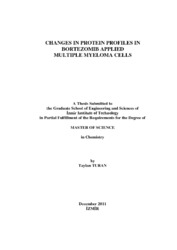Please use this identifier to cite or link to this item:
https://hdl.handle.net/11147/3182Full metadata record
| DC Field | Value | Language |
|---|---|---|
| dc.contributor.advisor | Şanlı Mohamed, Gülşah | en |
| dc.contributor.author | Turan, Taylan | - |
| dc.date.accessioned | 2014-07-22T13:51:02Z | - |
| dc.date.available | 2014-07-22T13:51:02Z | - |
| dc.date.issued | 2011 | en |
| dc.identifier.uri | http://hdl.handle.net/11147/3182 | - |
| dc.description | Thesis (Master)--İzmir Institute of Technology, Chemistry, İzmir, 2011 | en |
| dc.description | Includes bibliographical references (leaves: 89-101) | en |
| dc.description | Text in English; Abstract: Turkish and English | en |
| dc.description | xi, 111 leaves | en |
| dc.description.abstract | Multiple Myeloma is a malignant B-cell neoplasm that is characterized by the accumulation of malignant plasma cells in the bone marrow. Over the recent years, several novel agents have been introduced in the treatment of this disease. Bortezomib is the first of a new class of agents known as proteasome inhibitors. The main objective of the project was basically to both determine the cytotoxic and apoptotic effects of Bortezomib on Multiple Myeloma U-266 cells and compare and explore the differences between Bortezomib applied Multiple Myeloma cells and control group Multiple Myeloma cells, by proteomics studies. In order to achieve our aims in the project, variety of multidisciplinary subjects were come together. Cancer research techniques, biochemical studies at protein level and proteomics were combined in our studies. In this study, our experimental results demonstrated that Bortezomib has antiproliferative and apoptotic effects on MM U-266 cells. On the other hand, the responsible proteins for the effect mechanism of anti-cancer agent on cells were determined by MALDI-TOF-TOF Mass Spectrometry for the first time. According to the mass spectrometric analysis, 37 protein spots were differentially expressed. Among them, five proteins were newly formed, ten proteins lost, twelve proteins were up-regulated and ten proteins were down-regulated as compared to control group (untreated cells).These differential expressed proteins in response to Bortezomib have different important functions ranging from cell signaling transduction, cell cycle regulation, apoptosis to immunity and defense mechanism. In conclusion, it was identified which proteins have a central role behind the effect of Bortezomib on MM U-266 cells. The identified proteins may let to be possible to treat other cancer types by same anticancer agent. The data obtained by this study may also be helpful for medical schools and drug designers and may also provide new treatments. | en |
| dc.language.iso | en | en_US |
| dc.publisher | Izmir Institute of Technology | en_US |
| dc.rights | info:eu-repo/semantics/openAccess | en_US |
| dc.subject.lcsh | Multiple myeloma | en |
| dc.subject.lcsh | Time-of-flight mass spectrometry | en |
| dc.subject.lcsh | Antineoplastic agents | en |
| dc.subject.lcsh | Proteomics | en |
| dc.title | Changes in protein profiles in Bortezomib applied Multiple Myeloma cells | en_US |
| dc.type | Master Thesis | en_US |
| dc.institutionauthor | Turan, Taylan | - |
| dc.department | Thesis (Master)--İzmir Institute of Technology, Chemistry | en_US |
| dc.relation.publicationcategory | Tez | en_US |
| item.fulltext | With Fulltext | - |
| item.grantfulltext | open | - |
| item.languageiso639-1 | en | - |
| item.openairecristype | http://purl.org/coar/resource_type/c_18cf | - |
| item.cerifentitytype | Publications | - |
| item.openairetype | Master Thesis | - |
| Appears in Collections: | Master Degree / Yüksek Lisans Tezleri | |
Files in This Item:
| File | Description | Size | Format | |
|---|---|---|---|---|
| T001001.pdf | MasterThesis | 2.72 MB | Adobe PDF |  View/Open |
CORE Recommender
Page view(s)
214
checked on Nov 18, 2024
Download(s)
82
checked on Nov 18, 2024
Google ScholarTM
Check
Items in GCRIS Repository are protected by copyright, with all rights reserved, unless otherwise indicated.